I never met Nonna Lina, my husband’s grandmother. She passed away six weeks before I met him, coincidentally on the exact same day my maternal grandfather died. But from the way my husband and my mother-in-law talk about her, the constant references to her, especially when we are in the kitchen, I feel like I know her. And I feel connected to her when I cook her recipes.
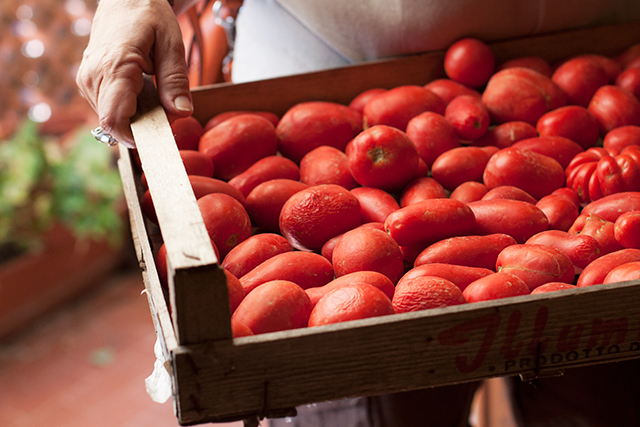
Lina was tiny, little Tuscan lady, and a good cook. A pedantic one. But the best one in the family, everyone always agrees. She had a tendency to over-cater – the worst thing that could happen during a meal is that someone leave the table hungry. This is a trait that was passed down to my mother-in-law, Angela.
The other day, while visiting Angela, I was offered a crate full of tomatoes, picked right out of the backyard garden. They were being left to mature in the garden shed but Lorella, Angela’s niece, was leaving for the seaside and didn’t have time to make the usual pomarola — bottled tomato sauce. So I piped up. I never say no to free produce and particularly not the things Lorella has excess of — she has supplied me in the past with rose petals for jam and green walnuts for liqueur, not to mention stinging nettle for tortellini, foraged from the weeds around the walnut tree.
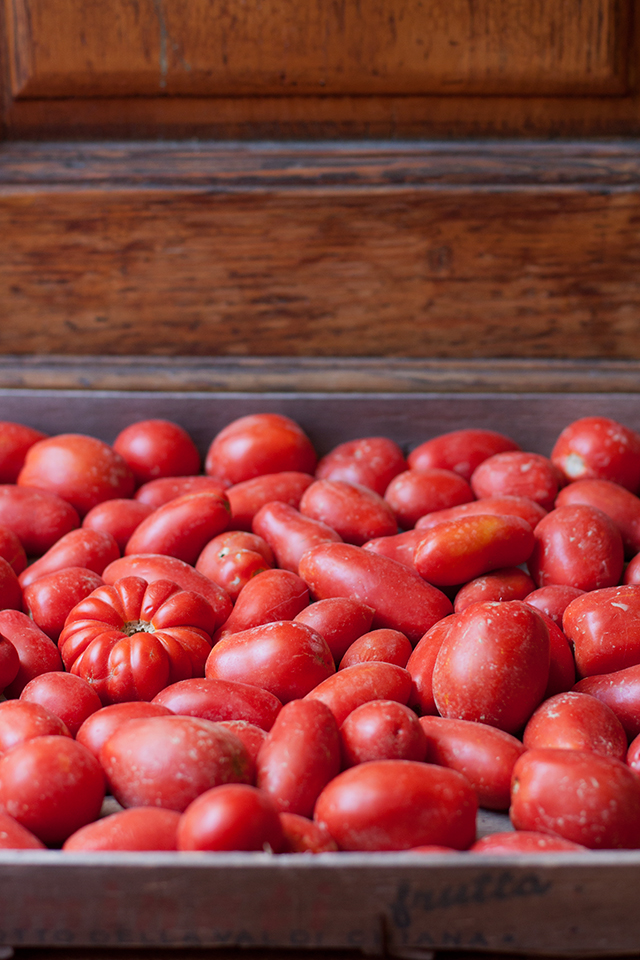
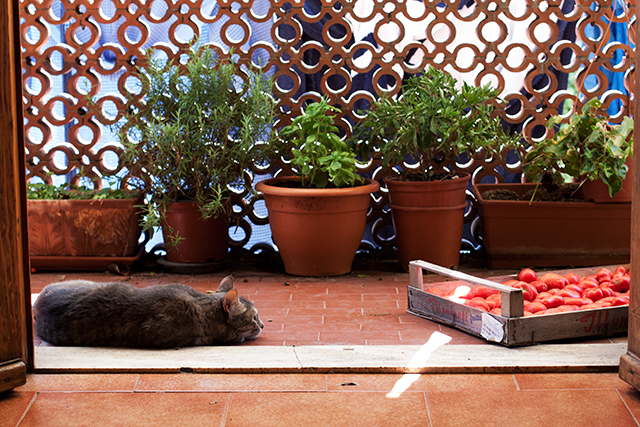
I’ve always wanted to make pomarola – that oh so Italian tradition that encompasses everything we think of about Italian food: family, seasonality, self-sufficiency and copious amounts of tomato sauce. Pomarola is a Tuscan tradition of tomatoes — a mix of San Marzano (also known as Roma tomatoes in Australia) or ribbed tomatoes known as Fiorentini or Cuore di Bue (Bull heart) is great — cooked with what Italians call aromi, aromas. It could be simply basil, or aromi can mean that trilogy of carrot, celery and onion. The resulting stew of sorts is passed through a passaverdura, or food mill or mouli, then bottled and stored away for those nights when all you have energy for is to boil some pasta and tip over some delicious tomato sauce.
Allow me a slight tangent. I don’t know how this could be done without the help of a passaverdura. A blender will not do. Passing 4 kilos of tomatoes through a sieve will certainly build character (and muscles) but I don’t think anyone will be pleased about having to do it. A food mill is a must in an Italian kitchen. It’s not a fancy contraption but rather old fashioned and chunky, even awkward at times when trying to balance it above a bowl or a pot that isn’t really the right size. It reminds me a little of those flour sifters with a spring-mounted handle that sweeps the flour through mesh. But more sophisticated: it manages to separate unwanted fibres, seeds and chunky bits, while at the same time turning the vegetables into a silky, smooth sauce. And once you have one, you will see, you’ll use it for everything — jam (this was a revelation for me; no need to skin and pit your fruit, just pop it all in, the food mill does the rest later), sauce, soup. It’s wonderful.
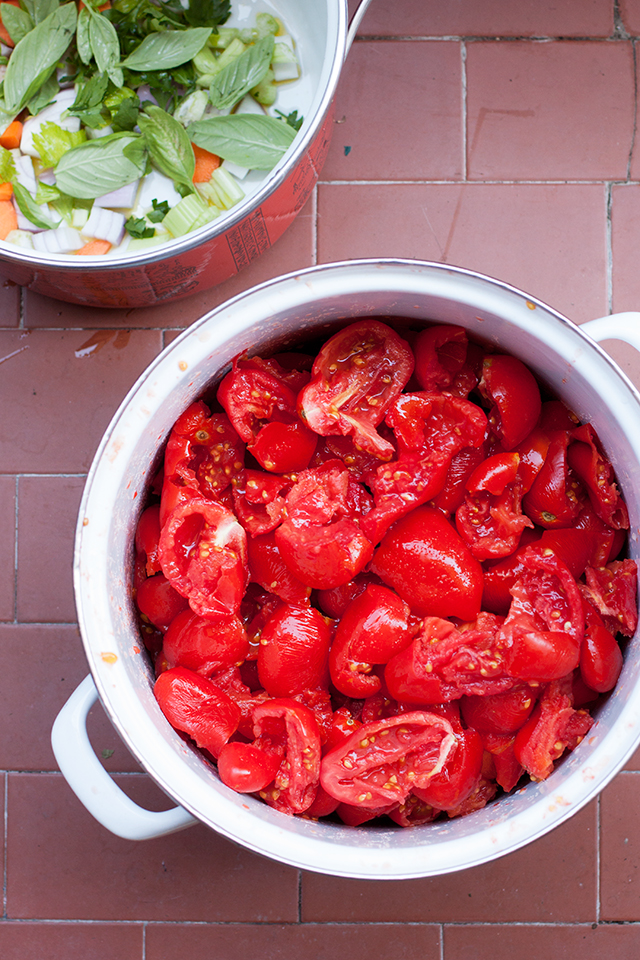
I saw Angela’s eye’s light up when I volunteered to make the pomarola, and she immediately gave me her mother’s recipe — she remembers all of Nonna Lina’s recipes as if it were yesterday that she was watching from the sidelines. But like so many oral recipes, I really didn’t have measurements to work with. Tomatoes, onion, carrot for sweetness, celery, parsley and basil – a lot of it. The tiniest bit of sugar to counteract the acidity of the tomatoes (this, I did not put in as I think it’s a bit of an old wives tale and honestly, it doesn’t need it. Taste first anyhow – this was already the sweetest pomarola all on account of the very sweet, very ripe tomatoes). Oil, just a little, if you want. Any water? Oh yes, some water, but especially if the tomatoes aren’t watery themselves.
Lina would break up the tomatoes in her hands as she put them in the pot. I did this, too, and realised about halfway through I should have been wearing an apron. The pot, the kitchen walls and myself were entirely covered in rather sinister looking spray of red tomato juice. There’s likely an easier way to do this (chopping roughly perhaps) but I do love a tactile recipe, an excuse to use my hands and ripping into the tomatoes seemed very much the most romantic way to make pomarola, even if the kitchen did look like a homicide scene afterwards.
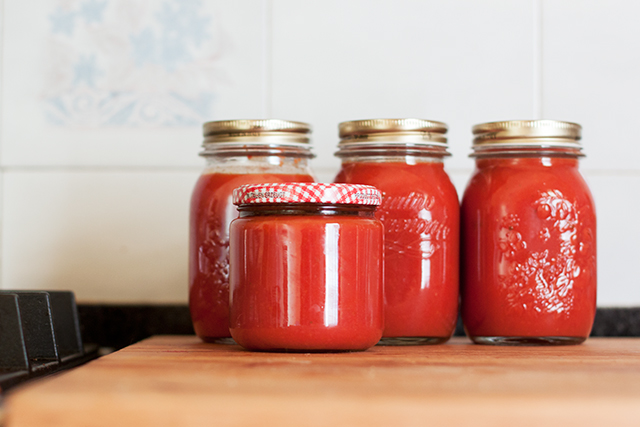
Nonna Lina’s Pomarola (Fresh Tuscan Tomato Sauce)
Makes about 2.5-3 kilos of sauce
- 4 kilos of tomatoes
- 1 large red onion, roughly chopped
- 1 large carrot, roughly chopped
- 2 celery stalks with leaves, roughly chopped
- ½ bunch of flat leaf parsley, torn
- ½ bunch of fresh basil leaves, torn
- salt
- about 250 ml (1 cup) water or so
- extra virgin olive oil
Wash the tomatoes well and begin ripping them up and putting them directly into a very large stock pot (or two medium-large ones, if you must). Add the chopped onion, carrot, celery and herbs and heat the pots over low-medium heat initially. As the pots warm, the tomatoes will begin to let out their juices. Season with salt — at this point I would add a pinch taken with 4 fingers, you also have another opportunity to season according to taste later. You may want to help them along by adding a splash of water — I used about 1 cup/250 ml.
Let the vegetables cook down, stirring occasionally so the ones at the top get a go of being at the bottom. As they do so, you will notice more and more liquid filling the pot. As soon as they are covered, turn the heat to low and let it all bubble away for about 40 minutes to 1 hour.
In the meantime, prepare jars for bottling. If you want to use it right away, you can also store it in the fridge and use over the next few days. Preparing jars for bottling is much like jam making and canning — use clean, glass jars and clean lids that have been washed well with warm soapy water and air dried. I used five jars that hold 500 ml of liquid each and had a bit left over.
Taste the tomatoes and adjust with perhaps another pinch of salt if it needs. If you think it’s too acidic, Lina would have added a pinch of sugar too, but this all depends on the tomatoes used (and I bet it’s just delicious without).
Remove from the heat and begin the food mill process — scoop out the vegetables bit by bit and pass them through a food mill set over a large pot (or a bowl but I find the mill is more likely to sit over a large pot — it has little legs that lift out for this — while a bowl will be too wide). Every now and then, when you have exhausted the leftover scraps in the food mill, tip this unwanted mess into the compost or bin, and carry on.
When the sauce is completely smooth, bring it back to a rolling heat, then distribute amongst the jars. Pour a layer of olive oil over the top of the sauce before closing the lid tightly and leave on your kitchen bench until the sauce has cooled and you hear that ‘pop’ of the lid sealing itself.
Original Website: Nonna Lina’s Pomarola | Emiko Davies


 English
English  中文
中文